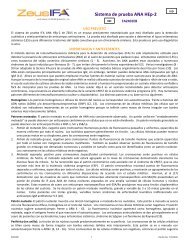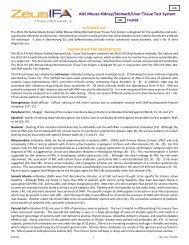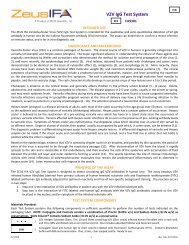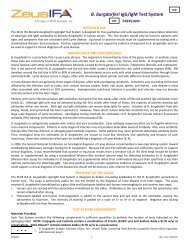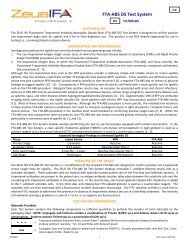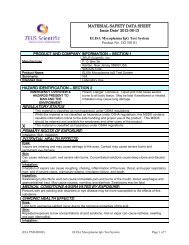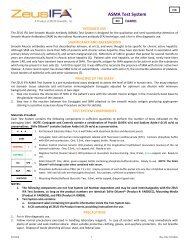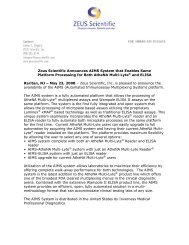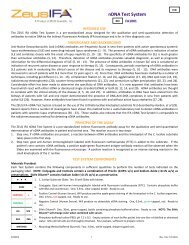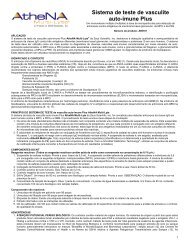English - ZEUS Scientific
English - ZEUS Scientific
English - ZEUS Scientific
Create successful ePaper yourself
Turn your PDF publications into a flip-book with our unique Google optimized e-Paper software.
3. Wash Slides for 3 - 5 minutes in PBS.<br />
4. Remove Slides from PBS and blot dry with six-well blotting paper. It is suggested that blotting paper be placed on a flat surface.<br />
Then place substrate Slide in an inverted position over the blotter. Press firmly on back of Slide. Do not allow tissue substrate<br />
to dry throughout the test procedure.<br />
5. With suitable dispenser (listed above), dispense 20µL of each Control and each diluted patient sera in the appropriate wells.<br />
6. Incubate Slides at room temperature (20 - 25°C) for 30 minutes.<br />
7. Gently rinse Slides with PBS. Do not direct a stream of PBS into the test wells.<br />
8. Wash Slides for two, 5 minute intervals, changing PBS between washes.<br />
9. Remove Slides from PBS one at a time. Invert Slide and key wells to holes in blotters provided. Blot Slide by wiping the reverse<br />
side with an absorbent wipe. CAUTION: Position the blotter and Slide on a hard, flat surface. Blotting on paper towels may<br />
destroy the Slide matrix. Do not allow the Slides to dry during the test procedure.<br />
10. Add 20µL of Conjugate to each well.<br />
11. Repeat steps 6 through 9.<br />
12. Apply 3 - 5 drops of Mounting Media to each Slide (between the wells) and coverslip. Examine Slides immediately with an<br />
appropriate fluorescence microscope.<br />
NOTE: If delay in examining Slides is anticipated, seal coverslip with clear nail polish and store in refrigerator. It is recommended<br />
that Slides be examined on the same day as testing.<br />
QUALITY CONTROL<br />
1. Every time the assay is run, the Positive Controls, a Negative Control and a Buffer Control must be included.<br />
2. It is recommended that one read the Positive and Negative Controls before evaluating test results. This will assist in establishing<br />
the references required to interpret the test sample. If Controls do not appear as described, results are invalid.<br />
a. Negative Control - characterized by the absence of fluorescent staining of the squamous epithelial cells, and/or basement<br />
membrane zone.<br />
b. Positive Controls - PV Positive control is characterized by any apple-green fluorescent staining between the squamous<br />
epithelial cells. The BP Positive Control is characterized by specific staining of the basement membrane zone.<br />
3. Additional Controls may be tested according to guidelines or requirements of local, state, and/or federal regulations or<br />
accrediting organizations.<br />
NOTES:<br />
a. The intensity of the observed fluorescence may vary with the microscope and filter system used.<br />
b. Non-specific reagent trapping may exist. It is important to adequately wash slides to eliminate false positive results.<br />
INTERPRETATION OF RESULTS<br />
1. Any apple-green staining of the specific structures noted above on a scale of 1+ to 4+ is considered positive. A 1+ is considered<br />
a weak reaction, and 4+ a strong reaction. All sera positive at a 1:10 dilution should be titered to endpoint dilution. This is<br />
accomplished by making 1:20, 1:40, 1:80, etc., serial dilutions of all positives. The endpoint is the highest dilution that produces<br />
a discernible positive reaction. Specific nuclear staining of the epithelial cell nuclei is considered a positive test for antinuclear<br />
antibodies which may be associated with SLE and other connective tissue diseases.<br />
2. Titers less than 1:10 are considered negative.<br />
3. Positive Test:<br />
a. Specific intercellular staining between the squamous epithelial cells is considered a positive test for pemphigus antibodies.<br />
b. Specific basement membrane zone staining is considered a positive test for bullous pemphigoid.<br />
LIMITATIONS OF THE ASSAY<br />
1. The <strong>ZEUS</strong> IFA ASA Test System is a laboratory aid and by itself is not diagnostic.<br />
2. The results should be interpreted in light of the patient’s clinical condition.<br />
3. No definitive association between the pattern of fluorescence and any specific disease state is intended with this product.<br />
4. No U.S. standard of potency.<br />
REFERENCES<br />
1. Cooperative study. Uses for Immunofluorescence test of skin and sera. Utilization immunofluorescence in the diagnosis of Bullous diseases, Lupus<br />
Erythematosus, and certain other dermatoses. Arch. Dermatol. 111:372-381, 1975.<br />
2. Jablonski S, Chorzelski TP, Beutner EH, et al: Indications for skin and serum immunofluorescent studies in dermatology. In: Beutner EH, Chorzelski TP, Bean S, et<br />
al (Eds): Immunopathology of the Skin. Stroudsburg, PA, Dowden, Hutchinson, and Ross, pp. 1-24, 1973.<br />
3. Chorzelski TP, Jablonski S, Beutner EH: Clinical significance of pemphigus antibodies in: Beutner EH, Chorzelski TP, Bean S, et al (Eds): Immunopathology of the<br />
Skin, Stroudsburg, PA, Dowden, Hutchinson, and Ross. pp. 25-43, 1973.<br />
4. Lever WF: Pemphigus and Pemphigoid. Springfield, IL, Charles C. Thomas, publisher. pp. 3-226, 1965.<br />
5. Michel B, Milner Y, David K: Preservation of Tissue-Fixed immunoglobulins in skin biopsies of patients with lupus erythematosus and bullous diseases:<br />
Preliminary report. J. Invest. Dermatology 59: 449-454, 1973.<br />
6. Anderson P, Hale WL: Immunohistology of human antibodies on monkey esophagus, In: Beutner EH, Chorzelski TP, Bean S, et al (Eds): Immunopathology of the<br />
Skin. Stroudsburg, PA, Dowden, Hutchinson, and Ross: pp. 271-286, 1973.<br />
R2030EN 4 (Rev. Date 7/8/2013)



